Introduction
Imagine a land where the verdant embrace of the jungle meets the sparkling waters of a volcanic lake. Ancient traditions blend seamlessly with daily life. Welcome to Ometepe Island, a hidden gem in Nicaragua’s stunning Lake Cocibolca. This tropical paradise, formed by the twin volcanic peaks of Concepción and Maderas, offers a feast for the senses with its lush landscapes, vibrant wildlife, and rich cultural heritage. As you wander through its serene streets and verdant trails, you’ll find that Ometepe’s charm extends beyond its natural beauty—it resonates deeply in its culinary delights.
Location
Nicaragua is located in Central America, bordered by Honduras to the north and Costa Rica to the south. It lies between the Pacific Ocean to the west and the Caribbean Sea to the east. Ometepe Island is in the southwestern part of Nicaragua, in the middle of Lake Cocibolca (Lake Nicaragua). The island is formed by two volcanic peaks, Concepción and Maderas, which rise dramatically from the lake, creating a stunning and unique landscape. Ometepe is accessible by ferry from the mainland town of San Jorge.
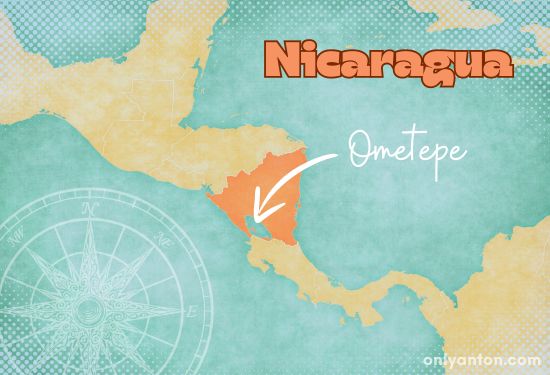
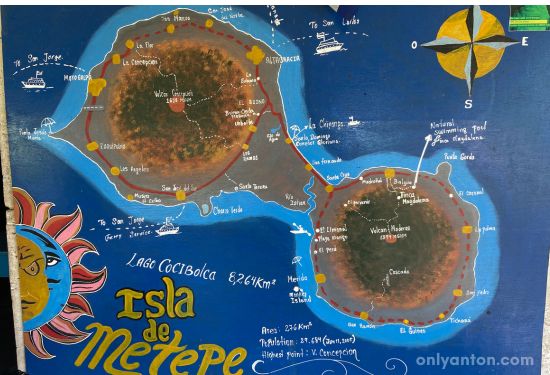
Nicaraguan cuisine is a vibrant tapestry of flavours, reflecting the island’s rich agricultural bounty and diverse cultural influences. On Ometepe Island, this culinary heritage comes to life with every meal. From the hearty Gallo Pinto, a staple of everyday Nicaraguan life, to the tangy, refreshing taste of fresh fruit juices, the island’s food scene is a celebration of simplicity and flavour. In this blog post, we’ll embark on a culinary journey to uncover the must-try dishes and beverages that define Ometepe’s local cuisine. Whether savouring the crisp crunch of fried plantains or indulging in a hearty bowl of Sopa de Mondongo, you’ll discover how each dish tells a story of tradition, community, and local pride. So, join me as we explore the flavours of Ometepe Island and learn why its culinary offerings are as captivating as its landscapes.
Nicaraguan Dishes
1. The National Dish: Gallo Pinto
Gallo Pinto, a beloved staple of Nicaraguan cuisine, is a hearty and flavourful blend of rice and beans. The dish’s name literally translates to “spotted rooster.” This name reflects the dish’s vibrant, mottled appearance, with the dark beans contrasting against the light rice. The beans are typically cooked with onions, peppers, and garlic. Then, this mixture is combined with rice to create a savoury, aromatic dish that embodies the essence of Nicaraguan home cooking.
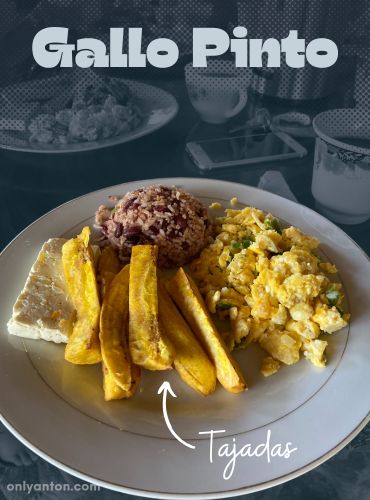
Gallo Pinto is often enjoyed as a breakfast dish. Typically, it is served with a variety of accompaniments that enhance its flavours and textures. Side dishes commonly include scrambled eggs, which add a rich, creamy element. Queso fresco, a mild, crumbly cheese complements the rice and beans. Fried plantains offer a sweet and crispy contrast to the savoury base. This combination of ingredients makes for a satisfying meal and provides a well-rounded start to the day.
Culturally, Gallo Pinto holds a special place in Nicaraguan cuisine. It is a symbol of everyday life and is often prepared in homes across the country and enjoyed by families of all backgrounds. As a breakfast staple, it represents the simplicity and comfort of traditional Nicaraguan cooking, bringing together ingredients that are both accessible and nourishing. Whether eaten at a local eatery or served in a family kitchen, Gallo Pinto is more than just a meal—it’s a cherished part of Nicaraguan heritage and daily life.
2. Plantains: Versatile and Delicious
A staple ingredient in Nicaraguan cuisine is plantains. They are cherished for their versatility and rich, satisfying flavour. Plantains add a delightful touch to any meal, whether sliced, fried, or incorporated into a street food platter.
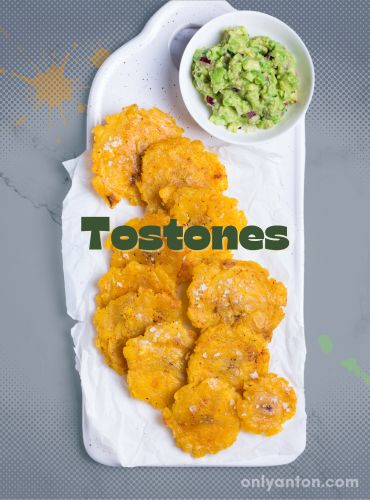
Tajadas are a popular way to enjoy plantains. In this preparation, plantains are sliced into thin rounds and fried until golden and crispy on the outside while remaining tender and slightly sweet. Tajadas offer a delicious contrast between their crunchy exterior and soft interior, making them a perfect accompaniment to various dishes. Their subtle sweetness and savoury flavour make them a favourite choice for many Nicaraguan meals.
Tostones, on the other hand, provide a different experience. These are twice-fried plantains, starting with slices fried once until soft, then smashed and fried again to achieve a crunchy texture. This double-frying process creates a crispiness that contrasts beautifully with the plantains’ natural sweetness. Tostones are often served with a sprinkle of salt and can be dipped in various sauces or eaten alongside other traditional dishes.
Plantains also play a central role in fritanga, a quintessential Nicaraguan street food platter. Fritanga typically features a mix of grilled meats, such as beef, pork, and chicken, accompanied by fried plantains, cheese, and other savoury sides. The plantains in fritanga add a delightful sweetness and texture to the ensemble, complementing the rich flavours of the grilled meats and enhancing the overall taste experience.
Each form of plantain showcases its unique characteristics, offering a variety of textures and tastes that enrich the Nicaraguan culinary landscape. From the crispy tajadas and crunchy tostones to the flavourful addition in fritanga, plantains are an integral part of Nicaraguan cuisine, celebrated for their versatility and deliciousness.
3. Nacatamales: A Traditional Delight
Another cherished Nicaraguan dish is Nacatamales. They are often considered a culinary centrepiece for special occasions and weekend gatherings. The preparation of nacatamales begins with a well-seasoned corn dough, which is spread out and filled with a hearty combination of tender pork, aromatic spices, rice, and vegetables such as bell peppers, tomatoes, and onions. The filling is then carefully wrapped in banana leaves, which impart a subtle, earthy aroma to the dish as it steams. This wrapping technique helps retain the flavours and moisture and gives nacatamales their distinctive presentation.
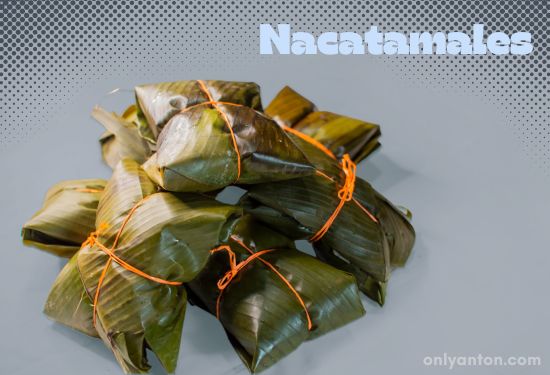
Nacatamales hold significant cultural importance in Nicaragua. Traditionally, they are a staple at family gatherings and special occasions, such as holidays and celebrations. Preparing nacatamales is often a communal activity. Families come together to create this delicious dish, making it a symbol of unity and shared culinary heritage. Nacatamales are a special treat on weekends, reflecting their status as a beloved comfort food that brings people together.
Whether served at festive gatherings or enjoyed as a comforting meal, nacatamales embody the heart and soul of Nicaraguan cuisine, offering a taste of tradition wrapped in every flavourful bite.
4. Quesillos: A Street Food Favourite
Quesillos are a beloved street food in Nicaragua. They offer a simple yet delicious combination of flavours and textures that make them a popular choice for a quick and satisfying meal. This tasty treat begins with a soft, warm tortilla generously stuffed with creamy cheese, tangy pickled onions, and a dollop of rich, velvety cream.
The tortilla used in quesillos is typically made from corn or flour, depending on regional preferences. Once filled, the tortilla is often folded or rolled, making it easy to enjoy on the go. The cheese inside melts slightly, creating a gooey, comforting bite. The pickled onions add a zesty contrast that complements the creamy texture of the cheese and cream.
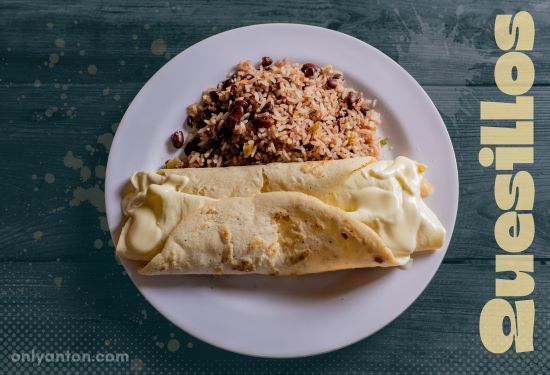
People commonly enjoy quesillos as a street food snack or a light meal. Often, a side of curtido (a type of cabbage slaw) accompanies the dish, adding crunch and flavour. You can find quesillos at various food stalls and markets, where they are freshly made and served warm. Some variations might include additional ingredients like hot sauce or avocado, enhancing the flavour profile to suit personal tastes.
Whether eaten as a quick bite while exploring the city or as a part of a casual meal, quesillos embody the vibrant and flavourful essence of Nicaraguan street food. Their simplicity and deliciousness make them a favourite among locals and visitors alike.
5. Fritanga: A Flavourful Street Food Experience
Fritanga is a quintessential Nicaraguan street food that combines a hearty mix of grilled meats, fried plantains, and cheese, making it an authentic taste of the local culinary scene. This vibrant dish typically features a variety of grilled meats, such as pork, beef, or chicken, seasoned and cooked to perfection. Crispy, twice-fried plantains, known as tostones or tajadas, complement the meats. A generous portion of fresh, tangy cheese is another traditional accompaniment.
The combination of flavours and textures in fritanga creates a satisfying and indulgent meal. The grilled meats often come with a side of fresh salsa or tangy cabbage slaw, adding a burst of freshness that balances the richness of the meat and plantains. The fried plantains provide a sweet and savoury contrast, while the cheese adds a creamy touch to each bite.
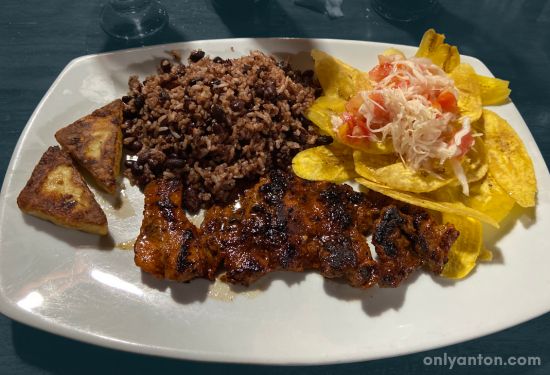
On Ometepe Island, Villa Paraiso is one of the best places to experience authentic fritanga. This popular restaurant is renowned for its delicious fritanga, offering a mouthwatering array of grilled meats, perfectly fried plantains, and flavourful cheese. The laid-back atmosphere and friendly service make Villa Paraiso an excellent spot to enjoy this beloved dish while soaking in the island’s charm.
Whether you’re a local or a visitor, indulging in fritanga at Villa Paraiso is a great way to experience the essence of Nicaraguan street food and immerse yourself in the island’s culinary culture.
6. Vigorón: A Tasty Nicaraguan Delight
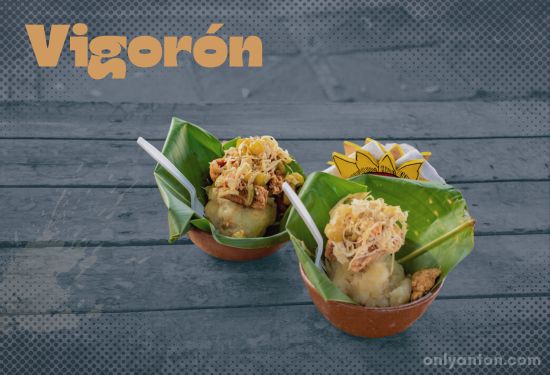
Vigorón is a traditional Nicaraguan dish featuring yuca (cassava) topped with crispy pork rinds and a tangy cabbage salad. It’s commonly served wrapped in banana leaves, adding an extra layer of flavour and a touch of authenticity to this beloved street food.
7. Indio Viejo
Indio Viejo is a rich Nicaraguan stew consisting of beef, corn, and a mix of vegetables simmered to perfection. Its name, meaning “Old Indian,” reflects its indigenous roots and traditional preparation methods. With its flavourful and comforting qualities, this hearty dish connects diners to Nicaragua’s historical and cultural heritage.
8. Churrasco con Chimichurri
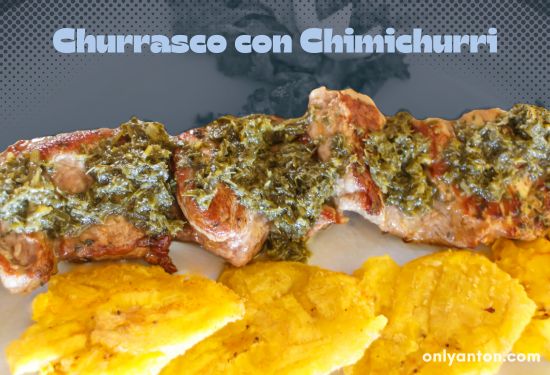
The Nicaraguan dish called Churrasco con Chimichurri features tender, grilled beef topped with a zesty chimichurri sauce made from parsley, garlic, vinegar, and oil. This flavourful dish is often served with traditional sides like rice, beans, and fried plantains, providing a well-rounded and satisfying meal.
9. Sopa de Mondongo
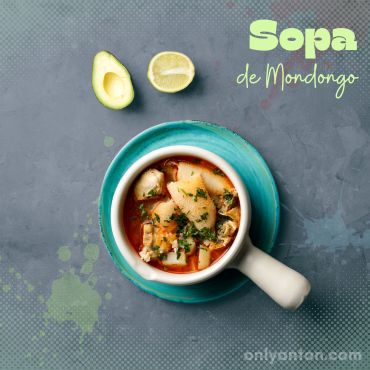
Sopa de Mondongo is a hearty tripe soup featuring a tender beef stomach cooked with vegetables like carrots, potatoes, and yucca in a delicious broth. This traditional dish is a staple at family gatherings and celebrations and is known for its rich flavours and comforting qualities.
10. Rosquillas
Rosquillas are crunchy corn cookies with a light, crisp texture and a hint of sweetness. These delightful treats are commonly enjoyed with coffee, making them a perfect snack or accompaniment for your morning brew.
Beverages
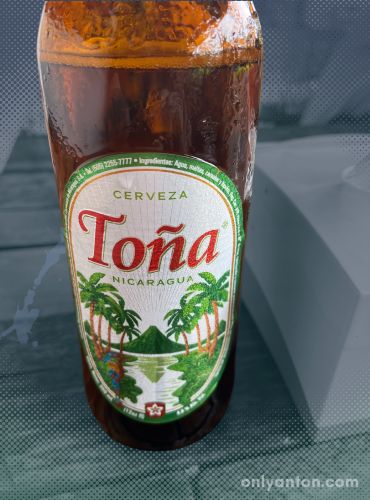
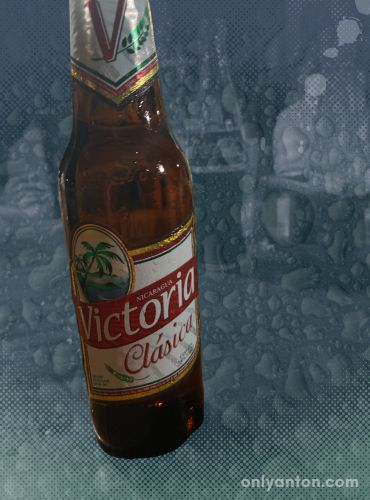
11. Toña and Victoria Beer
Two of Nicaragua’s most popular beers are Toña and Victoria. Each beer offers a refreshing taste of the country’s brewing tradition. Toña is a light lager with a crisp, clean taste, ideal for a hot day on the island. Victoria, also a lager, has a slightly richer taste with a touch of maltiness. Both beers are commonly enjoyed with the bottle open, a napkin wrapped around the neck and tucked into the open bottle mouth to prevent spills and ensure safety. On Ometepe, you can sample these brews at local spots like Restaurante El Pital or Café La Finca and enjoy the island’s laid-back atmosphere.
12. Coca-Cola in a Bag

In Nicaragua, enjoying a Coca-Cola takes on a unique twist: it’s served in a plastic bag. When you buy a Coke, the vendor opens the bottle and pours the soda into a plastic bag, which is then tightly sealed with a twist tie and a straw inserted. This unconventional presentation might seem unusual, but it’s a practical way to enjoy a chilled drink on the go, especially in warm weather. The bag keeps the soda cool and allows for easy sipping while you explore the island. It’s a quirky yet delightful local tradition that adds an extra layer of authenticity to your culinary adventure.
13. Flor de Caña Rum
Flor de Caña is Nicaragua’s renowned rum, celebrated for its smoothness and rich taste. This rum, distilled from the country’s finest sugarcane, boasts a range of expressions, from light and crisp to dark and complex. For a classic taste, enjoy it neat or on the rocks to appreciate its full depth. Alternatively, incorporate Flor de Caña into cocktails like a refreshing Mojito or a classic Cuba Libre, where its robust character shines through. Whether relaxing on the beach or enjoying a night out, Flor de Caña offers a distinct taste of Nicaraguan tradition.
14. Fresh Fruit and Juices
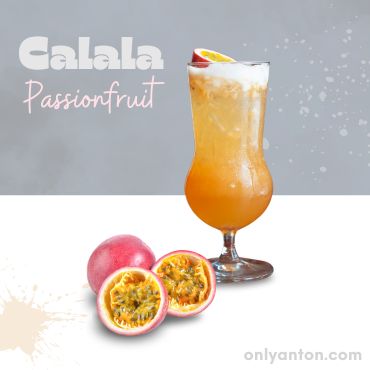
Calala (Passionfruit): Calala, or passionfruit, is renowned for its vibrant, tangy flavour and aromatic sweetness. Its juice is incredibly refreshing, offering a burst of tropical zest that’s both invigorating and satisfying.
Pineapple: Fresh pineapple juice is a local favourite, celebrated for its bright, sweet taste and refreshing qualities. On Ometepe Island, you might also encounter piña coladas, where fresh pineapple juice blends with rum and coconut for a creamy, tropical treat.
Other Juices: In addition to calala and pineapple, Ometepe Island offers a variety of fresh fruit juices, including mango, guava, and papaya. Each juice provides a taste of the island’s rich agricultural bounty and is a perfect way to cool down and enjoy the local flavours.
Conclusion
Ometepe Island offers a tantalizing culinary adventure with its diverse and delicious Nicaraguan dishes. From the national staple, Gallo Pinto, with its savoury mix of rice and beans, to the crispy plantains in various forms and the rich flavours of Nacatamales and Quesillos, each dish tells a story of tradition and flavour. You can savour the hearty Indio Viejo stew, indulge in the grilled delight of Churrasco con Chimichurri, and enjoy the comforting Sopa de Mondongo. Don’t miss out on the crunchy Rosquillas or the refreshing beverages like Toña and Victoria beers, Coca-Cola served in a bag and the iconic Flor de Caña rum. And, of course, the fresh fruit juices, including the vibrant calala, pineapple, and other tropical flavours, complete this flavourful journey.
One of my most memorable experiences was starting my day with a plate of Gallo Pinto, complemented by a block of salty cheese. It was a simple yet satisfying breakfast that perfectly captured the essence of Nicaraguan cuisine. The combination of flavours and textures made each bite a delightful experience, setting the tone for the day’s explorations.
What About You?
Have you tried any of these Nicaraguan dishes, or do you have other favourites from Ometepe Island? I’d love to hear about your experiences with Nicaraguan food or any questions you might have. Share your thoughts and stories in the comments below!
Further Reading and Resources
For those interested in diving deeper into Nicaraguan cuisine and culture, here are some valuable resources:
Related Posts on Only Anton
- Tasting Québec: Iconic Foods from Québec City and Montréal: Québec City and Montréal offer iconic Québecois cuisine. Discover where to enjoy them in this culinary guide.
- The Food of Barcelona: Explore Barcelona’s rich culinary scene, from traditional tapas to adventurous eats, and discover the city’s vibrant food culture.
- Cha Chaan Teng: Hong Kong’s Diner Food: Experience the fusion of flavours at Hong Kong’s cha chaan teng. Learn about the history and iconic dishes of these tea restaurants.
Books
- Nicaraguan Cooking: My Grandmother’s Recipes, by Trudy Espinoza-Abrams (2004): A treasury of traditional recipes from Granada, Nicaragua.
- The Flavors of Nicaragua: Traditional Recipes to Taste and Share, by Daniel Figliuzzi (2024).
Articles
- “How to Eat Like a Nicaraguan,” by Bridget Gleeson, Lonely Planet (April 2016): Provides a detailed overview of traditional Nicaraguan dishes and culinary practices.
Websites
- Nicaragua Tourism Official Website: Offers information on Nicaraguan food, travel tips, and cultural highlights.
Feel free to explore these resources to enhance your understanding and appreciation of Nicaraguan cuisine and culture!




